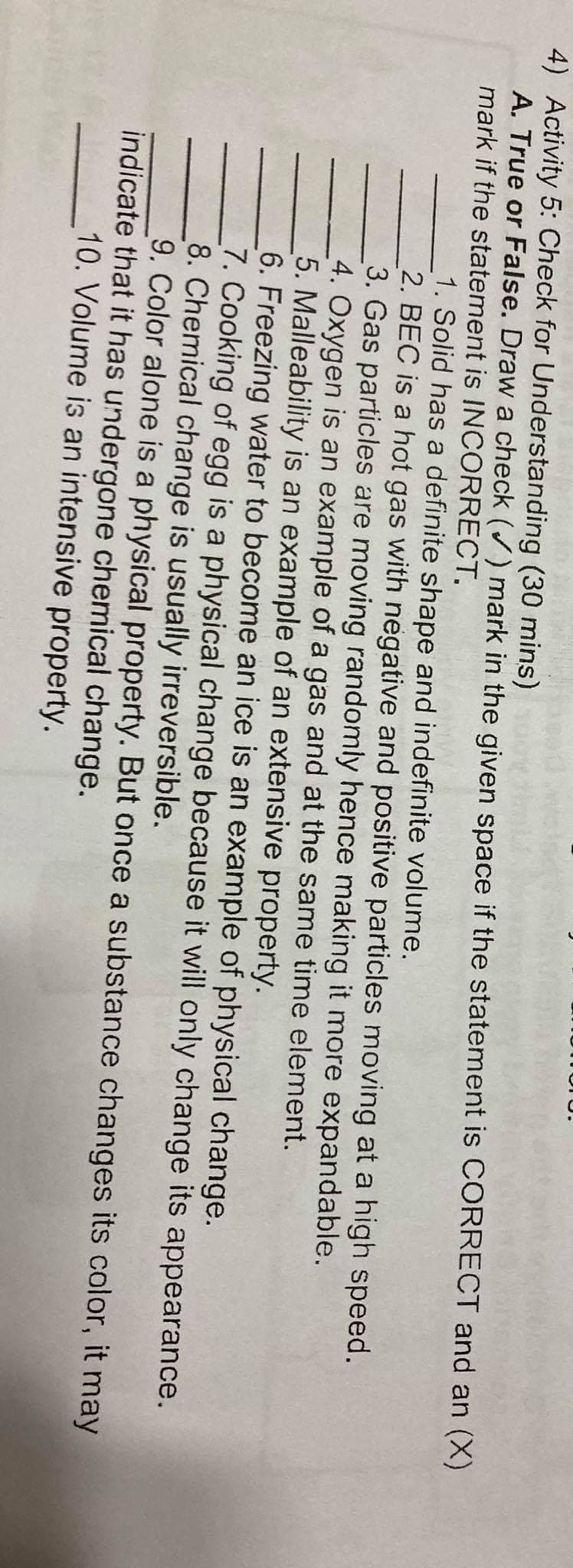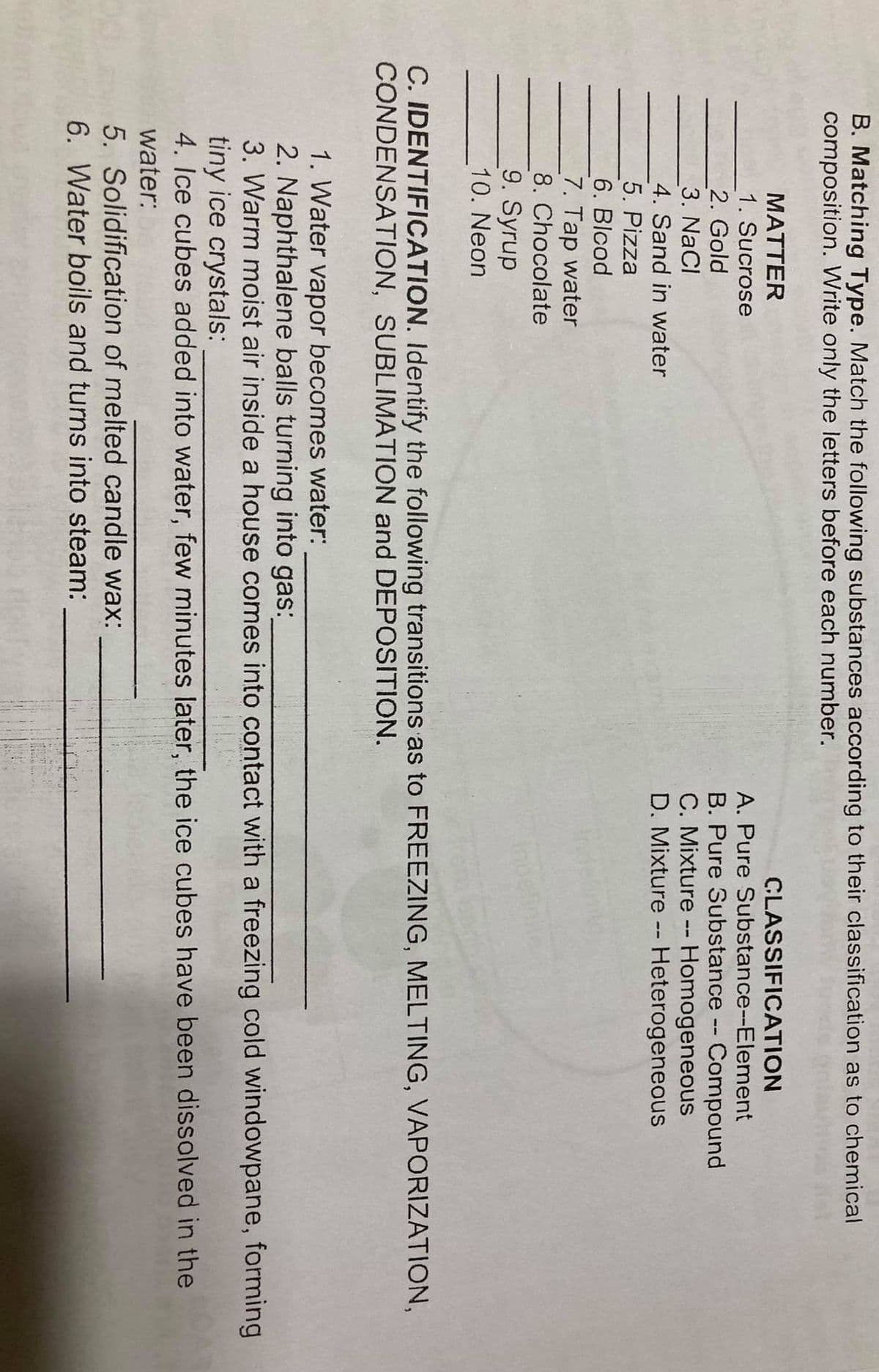JActivity 5: Check for Understanding (30 mi A. True or False. Draw a check (/) mark mark if the statement is INCORRECT. 1. Solid has a definite shape 2. BEC is a hot gas with neg 3. Gas particles are moving 4. Oxygen is an example of a 5. Malleability is an example 6. Freezing water to become 7. Cooking of egg is a physica 8. Chemical change is usually 9. Color alone is a physical pr indicate that it has undergone chemic 10. Volume is an intensive prc
JActivity 5: Check for Understanding (30 mi A. True or False. Draw a check (/) mark mark if the statement is INCORRECT. 1. Solid has a definite shape 2. BEC is a hot gas with neg 3. Gas particles are moving 4. Oxygen is an example of a 5. Malleability is an example 6. Freezing water to become 7. Cooking of egg is a physica 8. Chemical change is usually 9. Color alone is a physical pr indicate that it has undergone chemic 10. Volume is an intensive prc
Chemistry for Engineering Students
3rd Edition
ISBN:9781285199023
Author:Lawrence S. Brown, Tom Holme
Publisher:Lawrence S. Brown, Tom Holme
Chapter5: Gases
Section: Chapter Questions
Problem 5.3PAE
Related questions
Question
100%

Transcribed Image Text:4) Activity 5: Check for Understanding (30 mins)
A. True or False. Draw a check () mark in the given space if the statement is CORRECT and an (X)
mark if the statement is INCORRECT.
1. Solid has a definite shape and indefinite volume.
2. BEC is a hot gas with negative and positive particles moving at a high speed.
3. Gas particles are moving randomly hence making it more expandable.
4. Oxygen is an example of a gas and at the same time element.
5. Malleability is an example of an extensive property.
6. Freezing water to become an ice is an example of physical change.
7. Cooking of egg is a physical change because it will only change its appearance.
8. Chemical change is usually irreversible.
9. Color alone is a physical property. But once a substance changes its color, it may
indicate that it has undergone chemical change.
10. Volume is an intensive property.

Transcribed Image Text:B. Matching Type. Match the following substances according to their classification as to chemical
composition. Write only the letters before each number.
MATTER
CLASSIFICATION
1. Sucrose
2. Gold
3. NaCl
4. Sand in water
A. Pure Substance--Element
B. Pure Substance -- Compound
C. Mixture -- Homogeneous
D. Mixture -- Heterogeneous
5. Pizza
6. Blcod
7. Tap water
8. Chocolate
9. Syrup
10. Neon
C. IDENTIFICATION. Identify the following transitions as to FREEZING, MELTING, VAPORIZATION,
CONDENSATION, SUBLIMATION and DEPOSITION.
1. Water vapor becomes water:
2. Naphthalene balls turning into gas:_
3. Warm moist air inside a house comes into contact with a freezing cold windowpane, forming
tiny ice crystals:
4. Ice cubes added into water, few minutes later, the ice cubes have been dissolved in the
water:
5. Solidification of melted candle wax:
6. Water boils and turns into steam:
Expert Solution
This question has been solved!
Explore an expertly crafted, step-by-step solution for a thorough understanding of key concepts.
Step by step
Solved in 4 steps

Recommended textbooks for you

Chemistry for Engineering Students
Chemistry
ISBN:
9781285199023
Author:
Lawrence S. Brown, Tom Holme
Publisher:
Cengage Learning

Principles of Modern Chemistry
Chemistry
ISBN:
9781305079113
Author:
David W. Oxtoby, H. Pat Gillis, Laurie J. Butler
Publisher:
Cengage Learning

Chemistry for Engineering Students
Chemistry
ISBN:
9781337398909
Author:
Lawrence S. Brown, Tom Holme
Publisher:
Cengage Learning

Chemistry for Engineering Students
Chemistry
ISBN:
9781285199023
Author:
Lawrence S. Brown, Tom Holme
Publisher:
Cengage Learning

Principles of Modern Chemistry
Chemistry
ISBN:
9781305079113
Author:
David W. Oxtoby, H. Pat Gillis, Laurie J. Butler
Publisher:
Cengage Learning

Chemistry for Engineering Students
Chemistry
ISBN:
9781337398909
Author:
Lawrence S. Brown, Tom Holme
Publisher:
Cengage Learning


Chemistry: Principles and Reactions
Chemistry
ISBN:
9781305079373
Author:
William L. Masterton, Cecile N. Hurley
Publisher:
Cengage Learning

Introductory Chemistry: A Foundation
Chemistry
ISBN:
9781285199030
Author:
Steven S. Zumdahl, Donald J. DeCoste
Publisher:
Cengage Learning